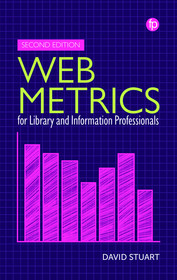
Web Metrics for Library and Information Professionals
- Publisher's listprice GBP 90.00
-
42 997 Ft (40 950 Ft + 5% VAT)
The price is estimated because at the time of ordering we do not know what conversion rates will apply to HUF / product currency when the book arrives. In case HUF is weaker, the price increases slightly, in case HUF is stronger, the price goes lower slightly.
- Discount 10% (cc. 4 300 Ft off)
- Discounted price 38 698 Ft (36 855 Ft + 5% VAT)
Subcribe now and take benefit of a favourable price.
Subscribe
42 997 Ft

Availability
Not yet published.
Why don't you give exact delivery time?
Delivery time is estimated on our previous experiences. We give estimations only, because we order from outside Hungary, and the delivery time mainly depends on how quickly the publisher supplies the book. Faster or slower deliveries both happen, but we do our best to supply as quickly as possible.
Product details:
- Edition number 1
- Publisher Facet Publishing
- Date of Publication 21 September 2023
- ISBN 9781783305674
- Binding Hardback
- No. of pages208 pages
- Size 234x156 mm
- Language English 497
Categories
Short description:
This book provides an up-to-date introduction to a wide range of web metrics, with practical examples of how they can b best put to use.
MoreLong description:
Library and information professionals increasingly need to create, manage, and monitor a wide range of online content, from a library’s social media account and web sites to the new and traditional research outputs that funders expect to be made available openly online. It is important that they understand the new opportunities that web metrics provide for measuring the impact of an individual or an organization’s content. This book provides an up-to-date introduction to a wide range of web metrics, with practical examples of how they can b best put to use. The book will begin with a wider discussion on the role of metrics, and how web metrics overlap with associated concepts with a longer library and information science history such as scientometrics and bibliometrics. It will explore the latest tools that are available, many of which have changed since the publication of the first edition, as well as how we can expect the field to change in the future with machine intelligence and artificial intelligence becoming more widely available. This new edition has been extended and updated throughout to reflect the rapidly changing nature of the field, and has been modified to incorporate important changes that have taken place in the information ecosystem since the first edition: increased use (and misuse) of metrics within institutions, the rapid growth of interest in altmetrics; the expanding potential of artificial intelligence; and the restrictions imposed by increased legislation in the data realm are all covered. As well as updates to the user-friendly tools and resources that are available, there is also a greater emphasis on the programming libraries that are available, as library and information professionals are increasingly willing to start engaging with data that is available programmatically. After reading the book the information professional will not only be better placed to adopt web metrics in their workplace, but also be critical of the misuse of web metrics.
MoreTable of Contents:
Web Metrics for Library and Information Professionals
More



